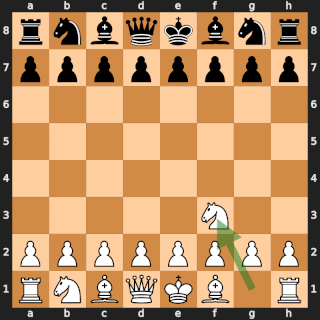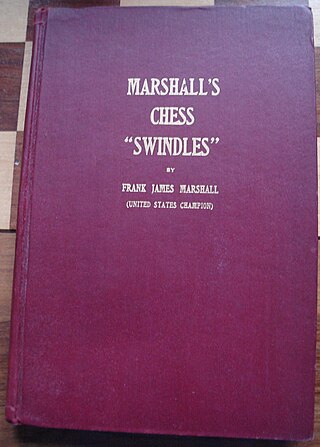
Algebraic notation is the standard method for recording and describing the moves in a game of chess. It is based on a system of coordinates to uniquely identify each square on the board. It is now almost universally used by books, magazines, newspapers and software, and is the only form of notation recognized by FIDE, the international chess governing body.
In the game of chess, perpetual check is a situation in which one player can play an unending series of checks, from which the defending player cannot escape. This typically arises when the player who is checking feels their position in the game is inferior, they cannot deliver checkmate, and wish to force a draw.

The Game of the Century is a chess game that was won by the 13-year-old future world champion Bobby Fischer against Donald Byrne in the Rosenwald Memorial Tournament at the Marshall Chess Club in New York City on October 17, 1956. In Chess Review, Hans Kmoch dubbed it "The Game of the Century" and wrote: "The following game, a stunning masterpiece of combination play performed by a boy of 13 against a formidable opponent, matches the finest on record in the history of chess prodigies."

In chess, a smothered mate is a checkmate delivered by a knight in which the mated king is unable to move because it is completely surrounded by its own pieces, which a knight can jump over.

The Hastings 1895 chess tournament was a round-robin tournament of chess conducted at the Brassey Institute in Hastings, England from 5 August to 2 September 1895.

The chess game between Emanuel Lasker and Johann Bauer played in Amsterdam in 1889 is one of the most famous on account of Lasker's sacrifice of both bishops to eliminate the pawn cover around his opponent's king, winning material and the game.

Carlos Jesús Torre Repetto was a Mexican chess player and the first from his country to be awarded the title of grandmaster, which was accorded by FIDE in 1977.
In chess, the Greek gift sacrifice, also known as the classical bishop sacrifice, is a typical sacrifice of a bishop by White playing Bxh7+ or Black playing Bxh2+ at some point after the opponent has castled kingside, with the goal generally being to attack and checkmate the opponent's king, or to regain material. It is important to consider the opponent's defenses.
In chess, a queen sacrifice is a move that sacrifices a queen, the most powerful piece, in return for some compensation, such as a tactical or positional advantage.
The chess endgame with a king and a pawn versus a king is one of the most important and fundamental endgames, other than the basic checkmates. It is an important endgame for chess players to master, since most other endgames have the potential of reducing to this type of endgame via exchanges of pieces. Players need to be able to determine quickly whether a given position is a win or a draw, and to know the technique for playing it. The crux of this endgame is whether or not the pawn can be promoted, so checkmate can be forced.
In chess, a fortress is an endgame drawing technique in which the side behind in material sets up a zone of protection that the opponent cannot penetrate. This might involve keeping the enemy king out of one's position, or a safe zone the enemy cannot force one out of. An elementary fortress is a theoretically drawn position with reduced material in which a passive defense will maintain the draw.
The rook and pawn versus rook endgame is a fundamentally important, widely studied chess endgame. Precise play is usually required in these positions. With optimal play, some complicated wins require sixty moves to either checkmate, capture the defending rook, or successfully promote the pawn. In some cases, thirty-five moves are required to advance the pawn once.
In chess, a desperado is a piece that is either en prise or trapped, but captures an enemy piece before it is itself captured in order to compensate the loss a little, or is used as a sacrifice that will result in stalemate if it is captured. The former case can arise in a situation where both sides have hanging pieces, in which case these pieces are used to win material prior to being captured. A desperado in the latter case is usually a rook or a queen; such a piece is sometimes also called crazy or mad.

In chess, a swindle is a ruse by which a player in a losing position tricks their opponent and thereby achieves a win or draw instead of the expected loss. It may also refer more generally to obtaining a win or draw from a clearly losing position. I. A. Horowitz and Fred Reinfeld distinguish among "traps", "pitfalls", and "swindles". In their terminology, a "trap" refers to a situation where players go wrong through their own efforts. In a "pitfall", the beneficiary of the pitfall plays an active role, creating a situation where a plausible move by the opponent will turn out badly. A "swindle" is a pitfall adopted by a player who has a clearly lost game. Horowitz and Reinfeld observe that swindles, "though ignored in virtually all chess books", "play an enormously important role in over-the-board chess, and decide the fate of countless games".

Levitsky versus Marshall, also known as the Gold Coins Game, is a famous game of chess played by Stepan Levitsky and Frank Marshall. It was played in Breslau on July 20, 1912, during the master's tournament of the DSB Congress. According to legend, after Marshall's winning last move of the game, gold coins were tossed onto the board by spectators, although this is contested by other accounts.
The 15th season of the Top Chess Engine Championship began on the 6 March 2019 and ended on 12 May 2019.
The 20th season of the Top Chess Engine Championship began on 1 December 2020 and ended on 1 February 2021. The defending champion was Stockfish, which defeated Leela Chess Zero in the previous season's superfinal. The season 20 superfinal was a rematch between the same two engines. Stockfish once again came out ahead, winning by 6 games.
The Traxler Counterattack, also known as the Wilkes-Barre Variation, is a chess opening that begins with the moves:
The queen versus rook endgame is a chess endgame where one player has just a king and queen, and the other player has just a king and rook. As no pawns are on the board, it is a pawnless chess endgame. The side with the queen wins with best play, except for a few rare positions where the queen is immediately lost, or because a draw by stalemate or perpetual check can be forced. However, the win is difficult to achieve in practice, especially against precise defense.









